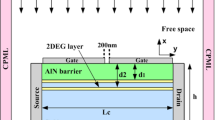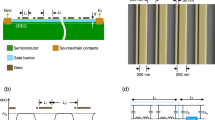Abstract
The full-wave analysis of the Dyakonov–Shur instability in an ungated short-channel high electron mobility transistor (HEMT) is investigated in this paper. This mechanism causes the emission of electromagnetic radiations by the device. The accurate analysis of the device is important especially when large electric fields are present. Herein, to analyze such structures, the complete hydrodynamic model, which is the simultaneous solution of Maxwell’s equations and the first three moments of the Boltzmann transport equation, is used. This model well describes the electron-wave interactions by considering the transport parameter variations with the electron energy and temperature. These variations are especially considerable when the emitter operates at high electromagnetic fields and were not considered in previous studies. The obtained results demonstrate the oscillation current along the channel and consequently the radiated power of the device are severely influenced by the transport parameter variations. The developed analysis method describes the behavior of the device as a terahertz emitter more accurately than the available ones.






Similar content being viewed by others
References
Akyildiza IF, Jornet JM, Han C (2014) Terahertz band: next frontier for wireless communications. Phys Commun 12:16–32
Wu L, Zhou X, Bai P (2014) Plasmonic metals for nanohole-array surface plasmon field-enhanced fluorescence spectroscopy biosensing. Plasmonics 9:825–833
Liu L, Ding H, Yong KT, Roy I, Law WC, Kopwitthaya A, Kumar R, Erogbogbo F, Zhang X, Prasad PN (2011) Application of gold nanorods for plasmonic and magnetic imaging of cancer cells. Plasmonics 6:105–112
Preu S, Mittendorff M, Winnerl S, Lu H, Gossard AC, Weber HB (2013) Ultra-fast transistor-based detectors for precise timing of near infrared and THz signals. Opt Express 21:17941–17950
Dyakonova N, But DB, Coquillat D, Knap W, Drexler C, Olbrich P, Karch J, Schafberger M, Ganichev SD, Ducournau G, Gaquiere C, Poisson MA, Delage S, Cywinski G, Skierbiszewski C (2015) AlGaN/GaN HEMT’s photoresponse to high intensity THz radiation. Opto-Electron Rev 23:195–199
Lü JQ, Shur MS, Hesler JL, Sun L, Weikle R (1998) Terahertz detector utilizing two-dimensional electronic fluid. IEEE Electron Device Lett 19:373–375
Otsuji T, Watanabe T, Tombet SAB, Satou A, Knap WM, Popov VV, Ryzhii M, Ryhzhii V (2013) Emission and detection of terahertz radiation using two-dimensional electrons in III-V semiconductors and grapheme. IEEE Trans Terahertz Sci Technol 3:63–71
Dyakonov M, Shur M (2005) Current instability and plasma waves generation in ungated two-dimensional electron layers. Appl Phys Lett 11:111501-1–111501-3
Dyakonov M, Shur M (1996) Detection, mixing, and frequency multiplication of terahertz radiation by two-dimensional electronic fluid. IEEE Trans Electron Devices 3:380–387
Nafari M, Aizin GR, Jornet JM (2018) Plasmonic HEMT terahertz transmitter based on the Dyakonov-Shur instability: performance analysis and impact of nonideal boundaries. Phys Rev Appl 10:064025-1–064025-12
Khorrami MA, El-Ghazaly S, Naseem H, Yu SQ (2014) Global modeling of active terahertz plasmonic devices. IEEE Trans THz Sci Technol 4:101–109
Bhardwaj S, Nahar NK, Rajan S, Volakis J (2016) Numerical analysis of terahertz emissions from an ungated HEMT using full-wave hydrodynamic model. IEEE Trans Electron Devices 63:990–996
Daneshmandian F, Abdipour A, Askarpour AN (2019) Full wave analysis of terahertz dispersive and lossy plasmonic HEMT using hydrodynamic model. J Opt Soc Am B 36:1138–1143
Daneshmandian F, Abdipour A, Askarpour AN (2019) Global modeling of terahertz plasmonic HEMT using complete hydrodynamic model. J Opt Soc Am B 36:3428-3433
Hussein YA, El-Ghazaly S, Goodnick SM (2003) An efficient electromagnetic-physics-based numerical technique for modeling and optimization of high-frequency multi finger transistors. IEEE Trans Microwave Theory Tech 51:2334–2346
Aste A, Vahldieck R (2003) Time-domain simulation of the full hydrodynamic model. Int J Numer Modell 16:161–174
Baccarani G, Wordemann MR (1985) An investigation of steady-state velocity overshoot in silicon. Solid State Electron 28:407–416
Nisar UA, Ashraf W, Qamara S (2016) A splitting scheme based on the space–time CE/SE method for solving multi-dimensional hydrodynamical models of semiconductor devices. Comput Phys Commun 205:69–86
Grondin RO, El-Ghazaly S, Goodnick S (1999) A review of global modeling of charge transport in semiconductors and full-wave electromagnetics. IEEE Trans Microwave Theory Tech 47:817–829
Taflove A, Hagness SC (2005) Computational electrodynamics: the finite-difference time-domain method, 3rd edn. Artech House, Norwood
Elsherbeni AZ , Demir V (2015) The finite-difference time-domain method in electromagnetics with MATLAB® simulations, 2nd ed. Sci. Tech. Publishing
Movahedi M, Abdipour A (2006) Efficient numerical methods for simulation of high-frequency active devices. IEEE Trans Microwave Theory Tech 54:2636–2645
Mirzavand R, Abdipour A, Moradi G, Movahhedi M (2012) Unconditionally stable MFLTD method for the full wave electromagnetic simulation. IEEE Trans Antennas Propag 60:2583–2586
Dyakonov M, Shur M (1993) Shallow water analogy for a ballistic field effect transistor: new mechanism of plasma wave generation by dc current. Phys Rev Lett 71:2465–2469
Cheremisin MV, Samsonidze GG (2008) Current instability and single-mode THz generation in ungated two-dimensional electron gas. Solid State Electron 52:338–340
Sullivan DM (2013) Electromagnetic simulation using the FDTD method, 2nd edn. Wiley-IEEE Press
Author information
Authors and Affiliations
Corresponding author
Additional information
Publisher’s Note
Springer Nature remains neutral with regard to jurisdictional claims in published maps and institutional affiliations.
Rights and permissions
About this article
Cite this article
Daneshmandian, F., Abdipour, A. & Askarpour, A.N. Numerical Investigation of the Instability-Based Power Emission from an Ungated Plasmonic HEMT Using Complete Hydrodynamic Model. Plasmonics 15, 1613–1620 (2020). https://doi.org/10.1007/s11468-020-01173-z
Received:
Accepted:
Published:
Issue Date:
DOI: https://doi.org/10.1007/s11468-020-01173-z




